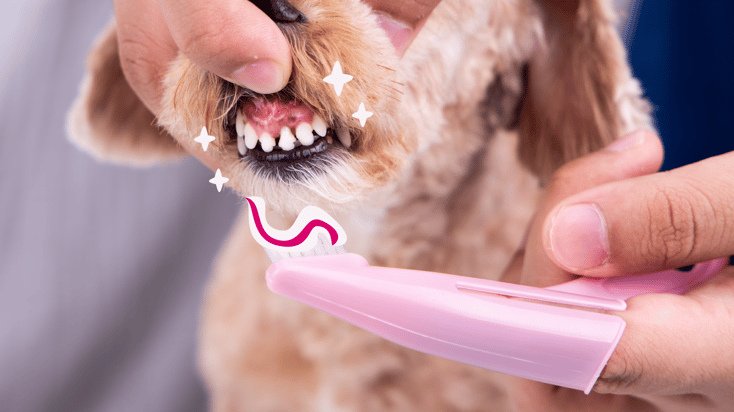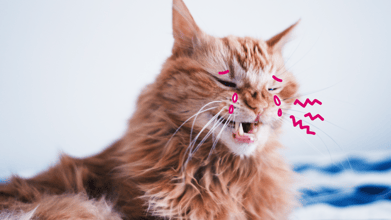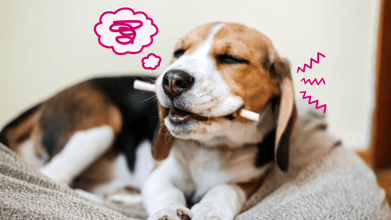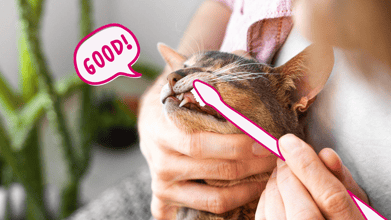What Happens During a Veterinary Pet Dental Cleaning?

Dental disease in cats and dogs is more common than you think. Therefore, a pet dental cleaning is an important component of your pet’s preventative care.
Professional dental assessment and cleaning under anesthesia allow us to thoroughly look for signs of dental disease in the mouth and back of the throat before they can cause symptoms.
BetterVet offers both mobile pet dental cleanings as well as on-site.
What Can You Expect with Your Pet’s Veterinary Dental Cleaning?
At BetterVet, your pet’s dental cleaning will be performed in one of our fully-equipped vehicles or at an on-site location. Dental cleaning is an important part of the Comprehensive Oral Health Assessment and Treatment (COHAT) process.
The COHAT includes the complete evaluation and treatment of your pet’s oral health and includes the following steps:
Step 1: Pre-anesthetic physical exam and blood work
An in-home Wellness Exam, during which your veterinarian will perform a physical exam and pre-anesthetic blood work, is required within two months of your pet’s dental procedure, or when recommended by your veterinarian.
We will evaluate any conditions that may require investigation or treatment to ensure safe use of anesthesia beforehand. Pre-anesthetic blood work can reveal health conditions that might make anesthesia dangerous.
Step 2: Administration of pre-medications
Next, we administer pre-medication to help calm and sedate your pet and allow us to place an intravenous (IV) catheter.
We often use pre-medications to decrease your pet’s anxiety and help them relax. Giving medication both before and after dental procedures is an effective way to treat dental pain.
Pet Dental Health Quiz
1. How often do you brush your pet’s teeth at home?
2. What color are your pet’s teeth?
3. When you look at your pet’s gums, which best describes what you see?
4. When you check your pet’s teeth, what do you see?
5. How does your pet respond to having their teeth or mouth touched?
6. When my pet eats, they:
7. When you kiss your pet you notice…
View Results
Step 3: Placement of an intravenous catheter
Once your pet is relaxed, we will place an Intravenous (IV) catheter that allows us to administer fluids and pain medications during the procedure.
IV fluids help maintain your pet’s hydration, blood pressure, and allow us to add any other medications as needed.
Step 4: Maintenance of general anesthesia
Anesthesia is necessary for a dental procedure to keep your pet safe and comfortable, and allows us to provide the best treatment possible. We use heat support and state-of-the-art monitors to ensure your pet is doing well throughout the procedure, from start to finish.
Step 5: Antibiotic injections
Updated dental guidelines indicate that antibiotics are not needed for all dental procedures, but some pets that have other medical or dental conditions may need them as a precautionary measure.
We will let you know ahead of time if your pet requires them, and send home oral antibiotics when necessary.
Step 6: Periodontal probing
Periodontal probing is a technique for assessing oral health and disease. As part of your pet’s oral exam, a periodontal probe tool is used to measure the distance between your pet’s gums and where they attach to their teeth, called a “pocket.”
All of your pet’s teeth are checked for pockets or changes and are noted on their dental chart.
Step 7: Dental X-rays
The next step, also Included in a BetterVet COHAT, is a set of full mouth X-rays. Pet X-rays can identify tooth root abscesses, retained or unerupted teeth, tooth resorption, and other problems that cannot be seen by the naked eye.
Step 8: Tartar Scaling
Next, we will use an ultrasonic scaler to remove tartar and calculus from all the little crevices of the tooth and from underneath the gum line.
This is an important step as the tartar below the gum line can cause the most significant periodontal disease.
Step 9: Tooth extractions
When necessary, we will extract any tooth that has evidence of bone loss or infection, didn’t erupt properly, or is broken.
Pets with advanced dental disease may require that some, many, or all of their teeth be extracted. As scary as this sounds, your pet will be more comfortable without painful teeth and will still be able to eat normally after healing.
Sometimes diseased or damaged teeth can be saved with restorative procedures (such as root canals) and may require referral to a board-certified veterinary dentist.
Step 10: Polishing and Sealant
Before your pet’s COHAT is complete, your veterinary team will perform a thorough teeth polishing and apply a fluoride sealant that helps slow down the re-accumulation of any new calculus.
This is the stage that leaves your pet’s teeth looking shinier and cleaner than when we began!
Step 11: Post-appointment pain medications
If there are extractions or other oral surgery, we will prescribe and send home oral pain medications.
Our goal is to make the dental cleaning experience as stress and pain-free as possible for your pet.
Conclusion
During every in-home Pet Wellness Exam with BetterVet, your veterinarian will conduct a thorough dental assessment and recommend any dental services your pet may need.
If your pet is due for a cleaning or other dental procedure, they can help you book your appointment at that time.
We believe in treating your whole pet, from nose-to-tail and preventative pet dental care is an important part of your pet’s wellness routine!
Don't Let Pet Dental Disease Sneak Up on Your Furry Friend
Regular checkups are crucial for maintaining your pet’s overall health and well-being. Our stress-free in-home visits make it easy to ensure your pet's oral health is always in top condition.
Frequently Asked Questions
Why is dental care important for my pet?
Regular dental care, including routine checkups and cleanings, are an important part of preventative wellness care, helping to prevent primary and secondary illness and infections that can develop from poor dental health.
Does pet insurance cover dental cleaning?
Depending on your individual policy, some pet insurance plans may cover dental accidents and illnesses, such as a chipped tooth or dental disease, but typically not routine dental care.
How often should you get your pet's teeth cleaned?
Many pets benefit from a full COHAT annually while others may be able to go a little longer. Your veterinarian will determine if your pet needs to be scheduled for a cleaning during their regular Wellness Exam.
What is included in the pet dental cleaning cost?
The cost of a professional dental cleaning for your pet includes a comprehensive assessment, dental X-rays that allow us to see the roots and bone surrounding each tooth, a scaling procedure, anesthesia, and any necessary medications and treatments.






